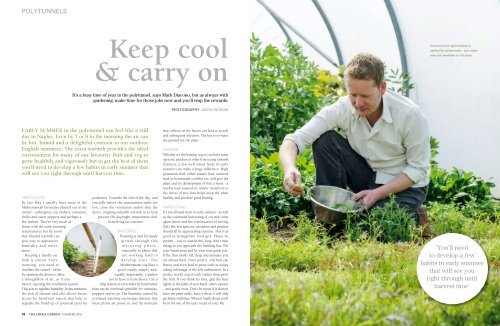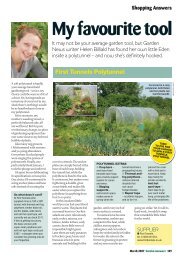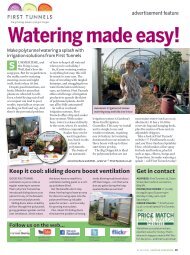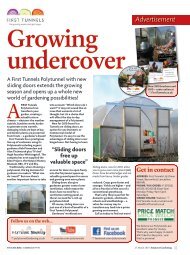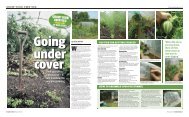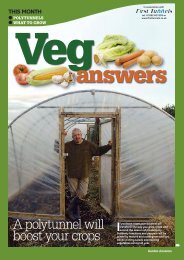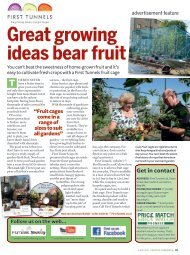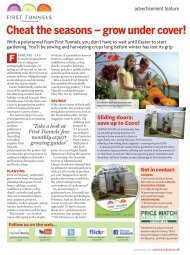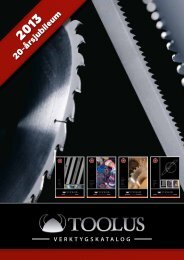Keep cool & carry on
You also want an ePaper? Increase the reach of your titles
YUMPU automatically turns print PDFs into web optimized ePapers that Google loves.
Polytunnels<br />
<str<strong>on</strong>g>Keep</str<strong>on</strong>g> <str<strong>on</strong>g>cool</str<strong>on</strong>g><br />
Cut and come again lettuce is<br />
perfect for polytunnels - just make<br />
sure you ventilate <strong>on</strong> hot days<br />
& <str<strong>on</strong>g>carry</str<strong>on</strong>g> <strong>on</strong><br />
It’s a busy time of year in the polytunnel, says Mark Diac<strong>on</strong>o, but as always with<br />
gardening, make time for those jobs now and you’ll reap the rewards.<br />
PHOTOGRAPHY JASON INGRAM<br />
EARLY SUMMER in the polytunnel can feel like a still<br />
day in Naples. Even by 7 or 8 in the morning the air can<br />
be hot, humid and a delightful c<strong>on</strong>trast to our outdoor<br />
English summers. The extra warmth provides the ideal<br />
envir<strong>on</strong>ment for many of our favourite fruit and veg to<br />
grow healthily and vigorously but to get the best of them<br />
you’ll need to develop a few habits in early summer that<br />
will see you right through until harvest time.<br />
VENTILATION<br />
By late May I usually have most of the<br />
Mediterranean favourites planted out in the<br />
tunnel - aubergines, cucumbers, tomatoes,<br />
chillis and sweet peppers and perhaps a<br />
few mel<strong>on</strong>s. They’re very much at<br />
home with the early morning<br />
temperatures but by no<strong>on</strong><br />
that blissful warmth can<br />
give way to oppressive<br />
humidity and water<br />
stress.<br />
<str<strong>on</strong>g>Keep</str<strong>on</strong>g>ing a handle <strong>on</strong><br />
both is crucial. Every<br />
morning, you need to<br />
ventilate the tunnel - either<br />
by opening the doors to allow<br />
a throughflow of air, or if you<br />
have it, opening the ventilati<strong>on</strong> system.<br />
This acts to regulate humidity, helps minimise<br />
the risk of disease and also allows better<br />
access for beneficial insects that help to<br />
regulate the build up of potential pests by<br />
predati<strong>on</strong>. Towards the end of the day, and<br />
crucially before the temperature sinks too<br />
low, close the ventilati<strong>on</strong> and/or shut the<br />
doors, trapping valuable warmth in to help<br />
prevent the day/night temperature shift<br />
from being too extreme.<br />
WATERING<br />
Watering is vital for steady<br />
growth through this<br />
m a t u r i n g p h a s e ,<br />
especially in plants that<br />
are working hard to<br />
d e v e l o p f r u i t . T h e<br />
Mediterranean veg likes a<br />
good steady supply and,<br />
equally importantly, it prefers<br />
not to have it from above. Use a<br />
drip system or even water by hand rather<br />
than use an overhead sprinkler for tomatoes,<br />
peppers and so <strong>on</strong>. The humidity caused by<br />
overhead watering encourages diseases that<br />
these plants are pr<strong>on</strong>e to, and the moisture<br />
that collects <strong>on</strong> the leaves can lead to scorch<br />
and subsequent infecti<strong>on</strong>. The key is to water<br />
the ground not the plant.<br />
FEEDING<br />
Whether it’s the fruiting veg or you have some<br />
apricots, peaches or other fruit racing towards<br />
ripeness, a few well timed feeds in early<br />
summer can make a huge difference. High<br />
potassium feed, either tomato feed, seaweed<br />
feed or homemade comfrey tea, will give the<br />
plant and it’s development of fruit a boost - a<br />
weekly feed watered in, and/or misted <strong>on</strong> to<br />
the leaves of tree fruit helps keep the plant<br />
healthy and promote good fruiting.<br />
HARVESTING<br />
It’s not all hard work in early summer - as well<br />
as the c<strong>on</strong>tinued harvesting of cut and come<br />
again leaves and the c<strong>on</strong>tinuati<strong>on</strong> of sowing<br />
(left), the first apricots, nectarines and peaches<br />
should all be approaching ripeness. This is as<br />
good as homegrown food gets. Please be<br />
patient - you’ve waited this l<strong>on</strong>g, d<strong>on</strong>’t ruin<br />
things as you approach the finishing line. Put<br />
your hands away and let your nose guide you.<br />
If the fruit smells full, deep and aromatic you<br />
are almost there. D<strong>on</strong>’t prod it - the fruit can<br />
bruise and even lead to pests such as wasps<br />
taking advantage of the soft indentati<strong>on</strong>. In a<br />
perfect world, you’d catch (rather than pick)<br />
the fruit. If you think it’s time, grip the fruit<br />
lightly in the palm of your hand - d<strong>on</strong>’t squeeze<br />
- and gently twist. D<strong>on</strong>’t be upset if it doesn’t<br />
leave the plant easily, leave it there, it will <strong>on</strong>ly<br />
get better with time. When it finally drops you’ll<br />
be in for <strong>on</strong>e of the tasty treats of your life.<br />
‘You’ll need<br />
to develop a few<br />
habits in early summer<br />
that will see you<br />
right through until<br />
harvest time’<br />
78 the Edible Garden SUMMEr 2012
POLYTUNNELS<br />
1<br />
2<br />
3<br />
4<br />
5<br />
Ventilati<strong>on</strong> will help keep pests and<br />
diseases in check by allowing air and<br />
predating insects in but the odd nuisance<br />
is inevitable. <str<strong>on</strong>g>Keep</str<strong>on</strong>g> a watchful eye, act early<br />
and be ready to order biological c<strong>on</strong>trols -<br />
such as the predatory wasp aphidius for<br />
c<strong>on</strong>trolling aphids, or the predatory mite<br />
Phytoseiulus persimilis for eradicating red<br />
spider mite - where necessary.<br />
Be aware of specific requirements that any<br />
of your polytunnel plants might have -<br />
stringing some shade netting between canes<br />
or hung from the bars can prevent potential<br />
scorching of sensitive plants; likewise, a minipolytunnel<br />
or cloche within the polytunnel<br />
will intensify c<strong>on</strong>diti<strong>on</strong>s if you’re trying<br />
something more exotic like bananas.<br />
It can be a busy time in the polytunnel but<br />
do find a moment to make any repairs should<br />
you damage the cover - holes can expand<br />
with the slightest pressure and valuable heat<br />
is lost through tears, especially at night. <str<strong>on</strong>g>Keep</str<strong>on</strong>g><br />
some specialist tape and some polytunnel<br />
plastic (see www.firsttunnels.co.uk) to hand<br />
and repair where needed immediately.<br />
Garden canes are the main culprit when it<br />
comes to polytunnel damage so work with<br />
these with care.<br />
Remember, many of your plants will be<br />
putting <strong>on</strong> str<strong>on</strong>g growth and/or developing<br />
heavy crops: give them some support. Tie<br />
tomatoes, chillis and peppers to canes or<br />
string hanging from the bars - the same for<br />
mel<strong>on</strong>s and cucumbers, if you aren’t letting<br />
them scramble.<br />
Lastly, if you have any salad leaves growing<br />
in the polytunnel at this time of year, keep<br />
cutting them - even if you can’t eat them. If<br />
you leave them they’ll bolt and become tough<br />
and bitter in a flash so keep cutting, passing<br />
<strong>on</strong> any you can’t eat to friends.<br />
CLOCKWISE FROM TOP RIGHT Water in the<br />
mornings by hand; twist peaches to harvest<br />
them - d<strong>on</strong>’t pull; aubergines will need support;<br />
tomatoes are gently tied in with garden twine -<br />
but not too tight so to damage stems<br />
Peaches, aubergine and tying in tomatoes/Mark Diac<strong>on</strong>o<br />
80 the Edible Garden


